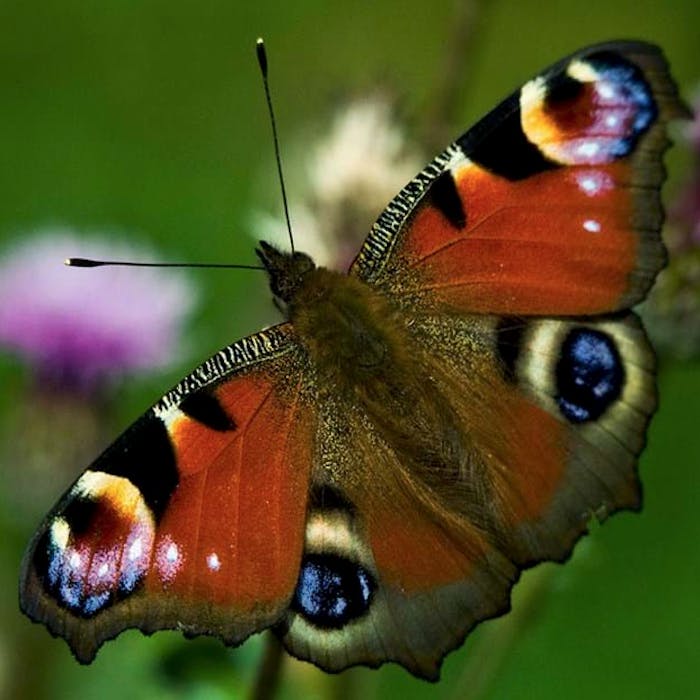
Peacock Butterfly - beauty in the eye of the beholder
The peacock butterfly is one of the most striking species of butterfly, and can commonly be found throughout the UK. This showstopper is instantly recognisable from the captivating azure ‘eyes’ on its orange-brown wings - evolved to confuse predators.
Their name reflects the similarity to the feathers of the peacock bird. A native species, it is to be seen in gardens, woodland areas and on forest edges.
Adult peacock butterflies are generally seen between March and September, with eggs laid between May and the beginning of June. Peacock caterpillars are black, with spines and small white spots and can be seen on stinging nettles from the end of May to the beginning of July. When they first hatch the baby caterpillars spin a web that they can live and feed in until they are large enough to move away. The chrysalis stage is a fragile cocoon to be found amongst the nettles.
The colour pattern on the peacock's wings is created by pigments contained in numerous tiny scales, which overlap each other, like the slates on a roof. Like all butterflies in the Nymphalidae family, the peacock’s front pair of legs are shortened and are not used for walking, being held folded against the thorax. The main features on the butterfly’s head are two large compound eyes, twin antennae with club ends, which are used for detecting airborne scents and air currents, and the proboscis, which is used for drinking nectar from plants and is held coiled when not in use.
Throughout its lifecycle, the peacock butterfly exhibits a quite sophisticated range of defence mechanisms against predators. The dark undersides of the wings provide excellent camouflage, both when the adult rests with its wings closed, and also during hibernation, when it is very hard to detect amongst dead leaves. If an adult is approached by a predator while its wings are closed, it will open them suddenly to reveal the eye spots, accompanied by a hissing sound made by rubbing its wings together. This mimicry can startle or confuse the predator, providing enough time for the butterfly to take flight and escape. A secondary function of the eye spots is that many birds will attack eyes first, so by having the spots towards the edge of its wings, the peacock is deflecting attacks away from its more vulnerable body. Experimental work with blue tits has shown that peacock butterflies with intact eye spots suffered much lower predation rates than those with missing spots. Butterflies are still able to fly with parts of their wings missing, usually caused by unsuccessful predation attempts.
The use of the stinging nettle as the larval food plant discourages some predators, while the communal silk web or tent and the spines on the caterpillar’s body act as further deterrents.
In late summer and autumn Peacock butterflies hibernate in sheltered places such as wood piles, stone walls, hollow tree trunks, garden sheds and buildings. Single or small numbers of butterflies will hibernate together with wings closed.
Further reading
Links to external websites are not maintained by Bite Sized Britain. They are provided to give users access to additional information. Bite Sized Britain is not responsible for the content of these external websites.
